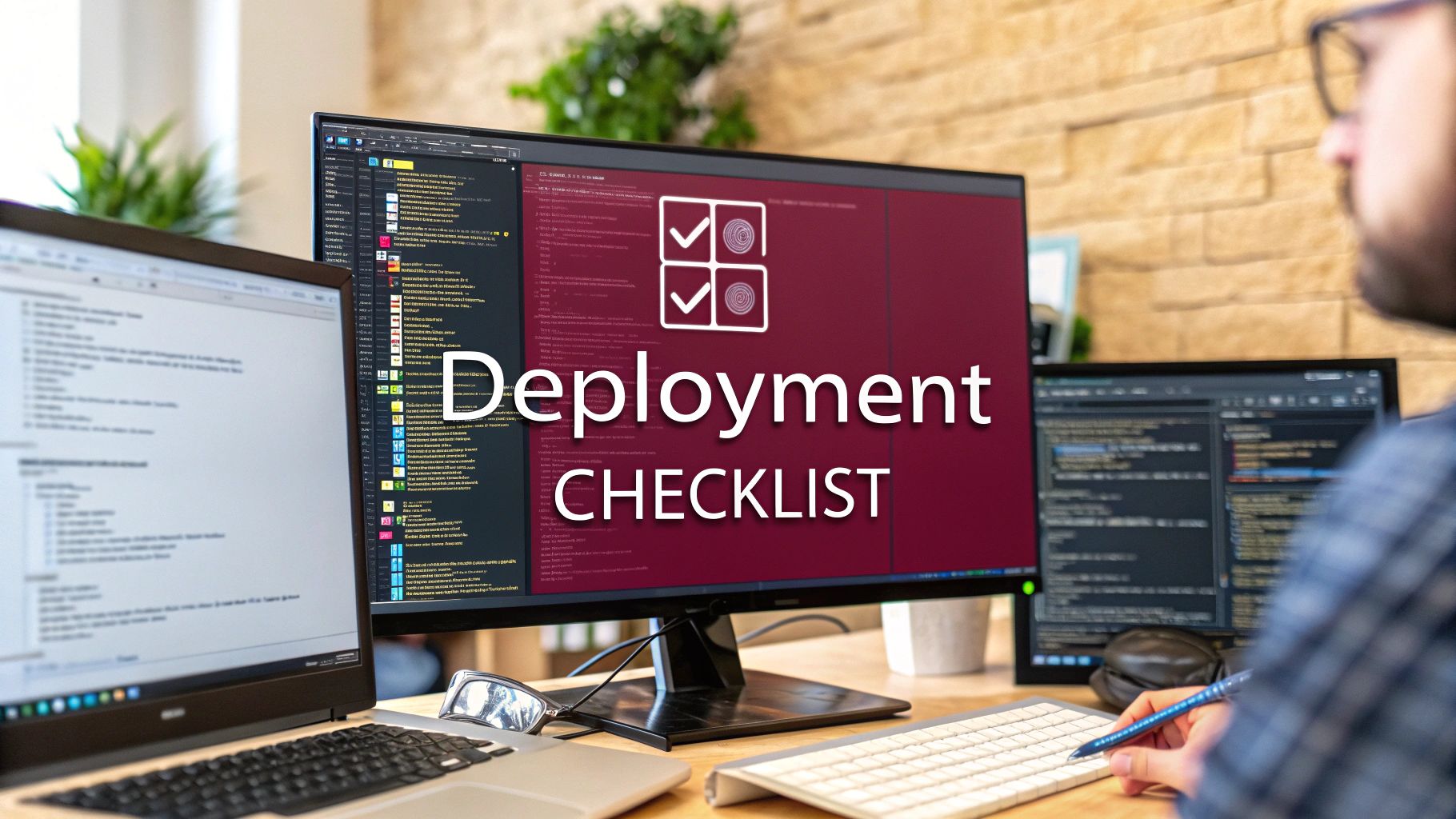Shipping code is the final, most critical step in the development lifecycle, yet it’s often fraught with risk. A single misstep can lead to system downtime, data corruption, or a frustrating user experience, undermining weeks of hard work. The difference between a smooth release and a chaotic rollback often comes down to one thing: preparation. A robust software deployment checklist acts as your team’s flight plan, ensuring every critical system, process, and dependency is accounted for before you hit the launch button.
This isn’t just about avoiding disaster; it’s about building a repeatable, scalable, and reliable process that empowers your team to deploy with confidence and speed. This structured approach becomes even more critical when moving applications to new infrastructure. For organizations planning to move their software to a cloud environment, adopting a comprehensive cloud migration checklist can provide invaluable structure and ensure every critical step is covered.
In this comprehensive guide, we’ll break down the seven essential stages of a modern deployment, providing actionable steps and expert insights to help you navigate from pre-flight checks to post-launch monitoring seamlessly. Let’s dive into the essential checks that will transform your deployment strategy from a high-stakes event into a routine, low-risk operation.
1. Pre-deployment Testing and Quality Assurance
A robust pre-deployment testing and quality assurance (QA) phase is the cornerstone of any successful software deployment checklist. This critical stage involves a comprehensive series of validations to ensure the software is functional, stable, secure, and performs as expected before it ever reaches end-users. It acts as a safety net, catching defects, performance bottlenecks, and security vulnerabilities early, preventing costly and reputation-damaging production failures.

This process isn’t a single action but a multi-layered strategy. It starts with developers running unit tests to verify individual code components and progresses to integration tests that check how different modules work together. Finally, system tests and User Acceptance Testing (UAT) validate the entire application against business requirements, ensuring it delivers the intended value.
Why It’s Crucial
Without thorough QA, you are essentially deploying blind. Minor bugs can cascade into major system outages, leading to user frustration, data loss, and significant financial impact. This step moves your deployment process from a game of chance to a structured, predictable, and reliable operation. Pioneers like Kent Beck (Test-Driven Development) and Martin Fowler (Continuous Integration) have long championed these practices for building resilient software.
Implementation in Practice
- Establish Clear Acceptance Criteria: Before any testing begins, define what “done” means. Your QA team should have clear, measurable criteria to validate against, leaving no room for ambiguity.
- Automate Extensively: Automate repetitive tests like regression suites to run with every new build. This frees up manual testers to focus on more complex exploratory testing and usability checks. Tools like Selenium, Cypress, and Jest are invaluable here.
- Use Production-like Environments: Testing in an environment that mirrors production is essential. This includes using similar hardware configurations, network settings, and anonymized production data to uncover issues that wouldn’t appear in a simplified dev environment.
- Document Everything: Keep detailed records of all test cases, their execution status, and any defects found. This documentation is vital for tracking progress, auditing, and referencing in future release cycles. For a deeper dive into specific testing protocols, particularly for mobile applications, you can learn more about how to test a mobile app.
2. Environment Configuration and Infrastructure Readiness
A flawless application can fail spectacularly if the environment it’s deployed to is misconfigured or unprepared. This step in the software deployment checklist involves the systematic preparation and validation of the target deployment environment. It covers everything from server configurations and network settings to database connections and third-party API keys, ensuring the production infrastructure is a perfect match for the new software version.

This process eliminates the notorious “but it worked on my machine” problem by creating consistent, repeatable, and scalable environments. Modern DevOps practices, pioneered by companies like HashiCorp and Amazon Web Services, treat infrastructure not as hardware to be manually configured but as code to be versioned, automated, and deployed just like the application itself. This approach drastically reduces human error and speeds up deployment cycles.
Why It’s Crucial
Deploying to an ill-prepared environment is a recipe for disaster. Mismatched library versions, incorrect database credentials, or misconfigured network firewalls can cause immediate and widespread outages. By validating infrastructure readiness beforehand, you ensure that the environment can handle the application’s demands for resources, dependencies, and security, guaranteeing a stable launch.
Implementation in Practice
- Use Infrastructure as Code (IaC): Treat your environment setup as code using tools like Terraform or AWS CloudFormation. This allows you to version, automate, and replicate your production environment with precision, eliminating configuration drift between staging and production. You can explore more on this topic by reading about Infrastructure as Code.
- Implement Environment-Specific Configurations: Store environment variables (like API keys and database URIs) securely and separately from your application code. Use a configuration management system or secrets manager (like HashiCorp Vault or AWS Secrets Manager) to inject the correct values at deployment time.
- Validate External Dependencies: Before deploying, run health checks to confirm that all external services, APIs, and databases are reachable and responsive from the production environment. This prevents failures caused by network issues or third-party outages.
- Document Environment Setup: Maintain clear and current documentation for your infrastructure. This is invaluable for onboarding new team members, troubleshooting issues, and performing disaster recovery.
3. Backup and Rollback Strategy
Even the most thoroughly tested software can encounter unexpected issues in a live production environment. A robust backup and rollback strategy is your critical safety net, providing a clear, fast, and reliable path to recovery. This part of your software deployment checklist involves preparing for the worst-case scenario by preserving system states, backing up critical data, and having a predefined procedure to revert to a stable, last-known-good version.

This strategy is not just about having backups; it’s a comprehensive plan that includes database snapshots, application version management, and configuration preservation. The goal is to minimize downtime and business impact by enabling a swift, controlled retreat from a failed deployment. Think of it as an insurance policy that ensures a faulty release doesn’t turn into a catastrophic failure.
Why It’s Crucial
Without a planned rollback procedure, a deployment failure can lead to frantic, error-prone manual interventions, extended outages, and potential data corruption. A well-defined strategy transforms a high-stress emergency into a manageable, predictable operation. This discipline, championed by pioneers like Martin Fowler and Jez Humble, is fundamental to continuous delivery and building resilient systems that can gracefully handle failure. To ensure your deployment can recover from unforeseen issues and maintain business continuity, consult an ultimate disaster recovery checklist.
Implementation in Practice
- Implement Immutable Deployments: Treat your infrastructure and application deployments as unchangeable. Instead of updating a server, you replace it with a new one containing the updated code. This makes rolling back as simple as deploying the previous immutable artifact, eliminating configuration drift.
- Test Your Rollback Procedures: A rollback plan is useless if it doesn’t work. Regularly test your rollback mechanisms in a staging environment to ensure they function as expected under pressure. This builds confidence and irons out any kinks before a real crisis occurs.
- Automate Rollback Triggers: Set up monitoring and alerting to automatically trigger a rollback if key performance indicators (KPIs) like error rates or latency spike beyond acceptable thresholds immediately after a deployment. This removes human delay and contains issues faster.
- Document Everything: Create clear, step-by-step documentation for the rollback process. This guide should be easily accessible to the entire engineering team, ensuring anyone on call can execute the recovery without confusion. For a more detailed guide, you can learn more about crafting a complete deployment rollback plan.
4. Database Migration and Data Integrity
A carefully planned database migration is a non-negotiable part of any modern software deployment checklist, especially when schema changes or data transformations are involved. This step addresses the challenge of evolving your database structure to support new features without causing downtime or corrupting valuable user data. It encompasses everything from versioning schema changes and writing migration scripts to validating data integrity before and after the deployment.

The process involves creating automated, repeatable scripts that apply changes to the database, such as adding a new table, altering a column, or seeding new data. These migrations are version-controlled alongside the application code, ensuring that the database state is always in sync with the application version. This systematic approach, popularized by frameworks like Ruby on Rails and tools such as Flyway and Liquibase, transforms a high-risk manual task into a controlled, auditable process.
Why It’s Crucial
Ignoring a structured migration strategy is a recipe for disaster. Manual database changes are error-prone and can lead to irreversible data loss, application crashes, and extended service outages. A robust migration plan ensures data consistency and backward compatibility, allowing you to deploy and even roll back changes safely. Companies like Stripe have famously mastered zero-downtime database migrations, proving that with the right process, even the most critical infrastructure can be updated seamlessly.
Implementation in Practice
- Use a Dedicated Migration Tool: Adopt tools like Flyway or Liquibase to automate and version your database changes. These tools track which migrations have been applied and ensure they run only once, preventing inconsistencies across different environments.
- Test Migrations on Production-Sized Data: Always test your migration scripts on a staging environment that has a recent, anonymized copy of your production database. This helps uncover performance issues with large datasets that wouldn’t appear on a small developer database.
- Wrap Migrations in Transactions: Whenever your database engine supports it, run schema changes within a transaction. If any step of the migration fails, the entire transaction is rolled back, leaving the database in its original, consistent state.
- Decouple Database and Code Deployments: Use feature flags to separate the deployment of database changes from the code that uses them. This allows you to deploy a new schema ahead of time, verify its stability, and then activate the corresponding application features later, minimizing risk.
5. Security and Compliance Verification
Overlooking security and compliance is not an option in modern software deployment; it’s a direct invitation to data breaches, legal penalties, and irreparable brand damage. This step in your software deployment checklist involves a rigorous assessment to confirm that your application is fortified against threats and adheres to all relevant legal and industry regulations. It’s about proactively embedding security and compliance into the deployment pipeline, rather than treating them as afterthoughts.
This verification process encompasses multiple layers. It includes automated vulnerability scanning to detect common weaknesses, meticulous access control verification to ensure users only have the permissions they need, and validation of data protection measures like encryption. For regulated industries, it also means performing explicit checks to satisfy standards like PCI DSS for payment processors (e.g., PayPal), HIPAA for healthcare applications (e.g., Healthcare.gov), or SOX for financial institutions.
Why It’s Crucial
Deploying an insecure or non-compliant application can have catastrophic consequences, ranging from seven-figure fines to complete loss of customer trust. In today’s landscape, a single vulnerability can be exploited to compromise millions of user records. This verification step transforms security from a reactive, panicked response into a proactive, systematic discipline. Organizations like OWASP (Open Web Application Security Project) and frameworks from NIST have been instrumental in establishing the best practices that make this possible.
Implementation in Practice
- Integrate Security into CI/CD: Don’t wait until the final pre-deployment stage. Use Static Application Security Testing (SAST) and Dynamic Application Security Testing (DAST) tools directly within your CI/CD pipeline to catch vulnerabilities with every code commit.
- Automate Compliance Checks: Leverage specialized tools to automatically scan your infrastructure and application configurations against specific regulatory frameworks. This provides continuous assurance that you remain compliant as your system evolves.
- Conduct Regular Security Training: Your development team is your first line of defense. Regular training on secure coding practices, common attack vectors, and emerging threats empowers them to build more secure software from the ground up.
- Maintain a Compliance Artifacts Repository: Keep an organized and up-to-date inventory of all security requirements, audit reports, and compliance documentation. This is invaluable for internal audits, regulatory reviews, and proving due diligence. To get a better handle on the specific rules that might apply to your project, you can get more information about various app security standards.
6. Monitoring and Alerting Setup
Deployment is not the finish line; it’s the starting line for observing your software in the wild. A comprehensive monitoring and alerting setup is your eyes and ears post-deployment, providing real-time insights into application performance, system health, and user experience. This involves implementing tools and processes to track metrics, log events, and notify your team of anomalies before they escalate into major incidents.
This proactive approach allows you to move from a reactive “break-fix” model to a predictive one. It starts with instrumenting your code to emit key metrics (like response times and error rates) and structured logs. These data points are then fed into platforms where they can be visualized on dashboards and used to trigger automated alerts when predefined thresholds are breached. This ensures that every part of your software deployment checklist contributes to long-term operational excellence.
Why It’s Crucial
Without robust monitoring, you are operating in the dark. You won’t know if a new feature is causing a memory leak, if a database query is slowing down the entire system, or if users are encountering a spike in errors. Proactive monitoring, as popularized by Google’s Site Reliability Engineering (SRE) practices and APM solutions like Datadog, is fundamental to maintaining high availability and a positive user experience. It turns unknown problems into quantifiable, actionable data.
Implementation in Practice
- Start with Key Metrics: Don’t try to monitor everything at once. Begin by identifying the “golden signals” for your application: latency, traffic, errors, and saturation. These core metrics provide a high-level view of system health and user-facing performance.
- Establish Actionable Alerts: An alert should signify a problem that requires human intervention. Configure thresholds that are sensitive enough to catch real issues but not so sensitive that they create “alert fatigue.” Link alerts directly to runbooks or incident response procedures.
- Utilize Dashboards for Visibility: Create centralized dashboards using tools like Grafana or Kibana to visualize key metrics. Have both high-level business dashboards for product managers and detailed technical dashboards for engineers to facilitate quick diagnostics. For robust post-deployment observation, consider leveraging various herramientas de monitoreo en la nube to get a complete picture.
- Implement Synthetic Monitoring: Use synthetic checks to proactively simulate user journeys and test critical endpoints. This practice can often detect outages or degradations before your actual users do, providing an essential early warning. To explore the tools that make this possible, you can learn more about monitoring tools for DevOps.
7. Communication and Stakeholder Notification
A structured communication plan is an essential, yet often overlooked, component of a successful software deployment checklist. This process involves proactively informing all relevant parties about deployment schedules, potential impacts, and post-deployment status updates. It’s about ensuring that everyone from the development team and operations staff to customer support and business leaders is aligned and prepared for the change.
Effective communication transforms a deployment from a siloed technical event into a coordinated business operation. It requires a clear strategy for what information is shared, with whom, and when. This includes pre-deployment announcements, real-time progress updates during the rollout, and post-deployment summaries confirming success or detailing any issues that arose.
Why It’s Crucial
Without clear communication, deployments can cause chaos. Customer support teams might be blindsided by a flood of tickets about a new feature they didn’t know existed. Sales teams could misinform clients about system availability, and executives might be left in the dark during a critical outage. Frameworks like ITIL and modern DevOps practices emphasize communication to minimize disruption and manage expectations effectively. Transparent communication builds trust and ensures that if something does go wrong, the right people can respond swiftly and cohesively.
Implementation in Practice
- Create Standardized Communication Templates: Develop pre-approved templates for different deployment scenarios (e.g., major release, minor patch, emergency hotfix). This ensures consistency and saves valuable time, as seen in Atlassian’s and GitLab’s internal release communication workflows.
- Segment Communications by Audience: Tailor your messages to each stakeholder group. Engineers need technical details about the build version and server status, while customer support needs a summary of user-facing changes and potential issues. Business leaders may only need a high-level go/no-go notification and a final success summary.
- Leverage Automated Status Pages: Use tools like Statuspage.io to provide real-time, public-facing updates on system status during deployment. This reduces the burden on your support team by allowing users to self-serve information about planned maintenance or unexpected downtime.
- Establish Clear Escalation Paths: Document who to contact and how if the deployment encounters a critical issue. This “phone tree” should be clear and accessible, ensuring that decision-makers can be reached immediately to authorize a rollback or other emergency actions.
7-Step Software Deployment Checklist Comparison
| Item | Implementation Complexity 🔄 | Resource Requirements ⚡ | Expected Outcomes 📊 | Ideal Use Cases 💡 | Key Advantages ⭐ |
|---|---|---|---|---|---|
| Pre-deployment Testing and Quality Assurance | High - involves multiple test types and automation | High - dedicated testers and tools needed | High quality, fewer bugs, ensured functionality | Critical before production releases and major feature rollouts | Reduces downtime, builds confidence, early performance issues detection |
| Environment Configuration and Infrastructure Readiness | Medium to High - requires IaC and environment setup | Medium to High - infrastructure expertise and management tools | Stable, consistent and scalable environments | Deployments to production with infrastructure dependencies | Reduces deployment failures, ensures environment parity, supports scaling |
| Backup and Rollback Strategy | Medium - involves backup plans and automation | Medium - storage and tooling for backups required | Minimal downtime, fast recovery from failures | Critical for risk mitigation in deployments | Minimizes downtime, protects data, quick recovery enabled |
| Database Migration and Data Integrity | High - complex migrations and data validation | Medium to High - DBAs and migration tooling | Data consistency, uninterrupted application function | Schema changes, large data migrations | Prevents corruption, maintains functionality, ensures backward compatibility |
| Security and Compliance Verification | Medium to High - vulnerability assessments and compliance checks | Medium to High - security experts and tools required | Secure deployments, regulatory adherence | Regulated industries and security-sensitive apps | Prevents breaches, ensures compliance, builds trust |
| Monitoring and Alerting Setup | Medium - setup of dashboards and alerts | Medium - requires monitoring tools and maintenance | Proactive issue detection, improved MTTR | Post-deployment system health tracking | Enables rapid response, visibility, data-driven decisions |
| Communication and Stakeholder Notification | Low to Medium - communication planning and coordination | Low to Medium - communication platforms and time investment | Coordinated, transparent deployments | Large teams, multiple stakeholders involved | Reduces confusion, ensures preparedness, maintains transparency |
Beyond the Checklist: Cultivating a Culture of Deployment Excellence
Navigating the complexities of a modern software release can feel daunting. This comprehensive software deployment checklist serves as your roadmap, guiding you through the critical checkpoints from pre-deployment testing and environment configuration to security verification and stakeholder communication. Following these steps diligently mitigates risk, prevents costly downtime, and ensures a smoother, more predictable release process. It transforms a potentially chaotic event into a structured, manageable workflow.
However, the true power of this checklist isn’t just in ticking boxes during your next release cycle. Its ultimate value lies in serving as a blueprint for cultural change. The goal is to evolve beyond a manual, reactive process and cultivate a proactive culture of deployment excellence. This means internalizing these principles until they become second nature, automated, and deeply embedded in your team’s daily operations.
From Manual Steps to Automated Systems
A mature deployment pipeline doesn’t rely on human memory. The most effective teams use a software deployment checklist as a foundation to build robust automation.
- Codify Your Infrastructure: Use Infrastructure as Code (IaC) tools like Terraform or Ansible to make your environment configuration (Item #2) repeatable, version-controlled, and auditable.
- Automate Your Safeguards: Integrate your security scans (Item #5) and QA tests (Item #1) directly into your CI/CD pipeline. This creates an automated quality gate that prevents flawed code from ever reaching production.
- Streamline Your Rollbacks: Your rollback strategy (Item #3) shouldn’t be a frantic, manual procedure. It should be a single, automated command that can be executed instantly when monitoring (Item #6) detects an anomaly.
Empowering Teams with Ownership and Tools
A culture of deployment excellence thrives on empowerment. When developers have the tools and autonomy to own their code from the initial commit all the way to production monitoring, they are more invested in its quality and performance. This shift from siloed responsibilities to shared ownership is fundamental.
For teams building React Native applications, this cultural shift is particularly impactful. The traditional hurdles of app store reviews and delayed rollouts can stifle innovation and create a fear of frequent updates. This is where specialized tools become cultural enablers. They abstract away the friction points, allowing teams to focus on delivering value.
A great deployment process makes shipping software so routine and reliable that it becomes a non-event. The focus shifts from the anxiety of the release to the impact of the feature.
Ultimately, mastering your deployment process is a powerful competitive advantage. It allows you to ship better software, faster, and with greater confidence. By embracing the principles within this software deployment checklist, you’re not just improving a single release; you are building a more resilient, efficient, and innovative engineering organization.
Ready to automate a critical part of your React Native deployment process? CodePushGo provides a powerful platform for instant app updates, feature flags, and instant rollbacks, turning your software deployment checklist into an automated, stress-free reality. See how you can ship updates without waiting for app store reviews at CodePushGo.




